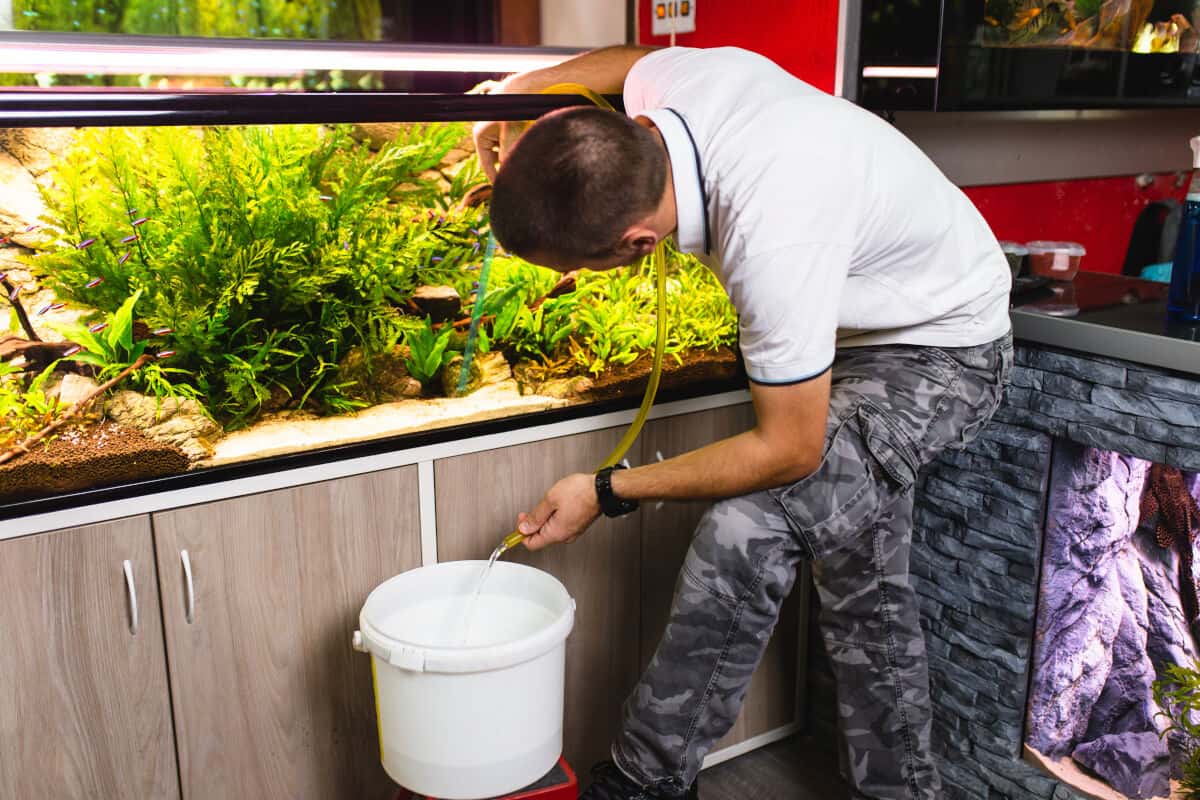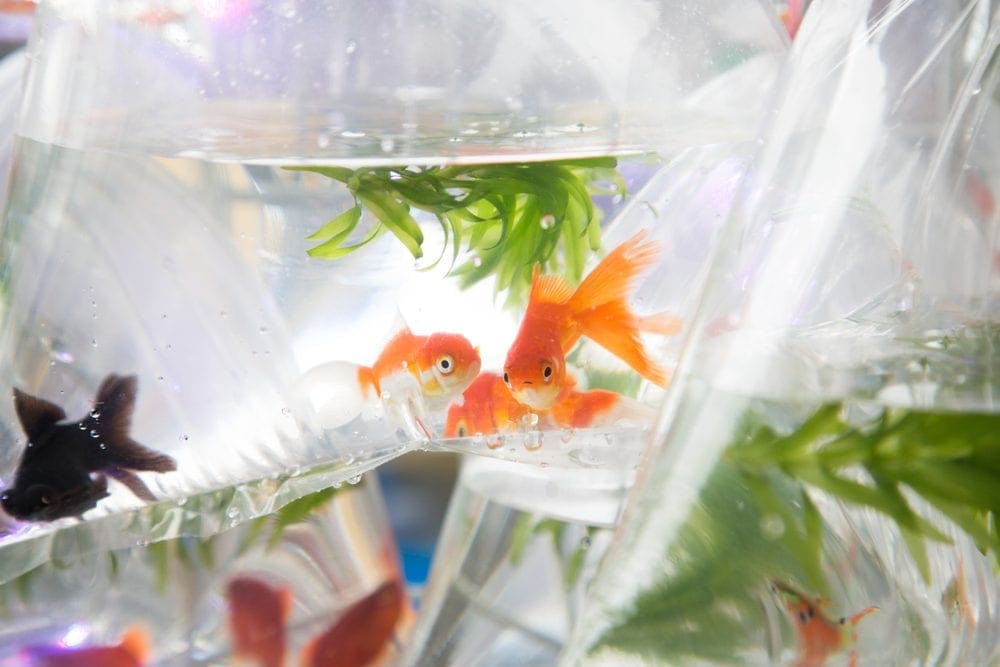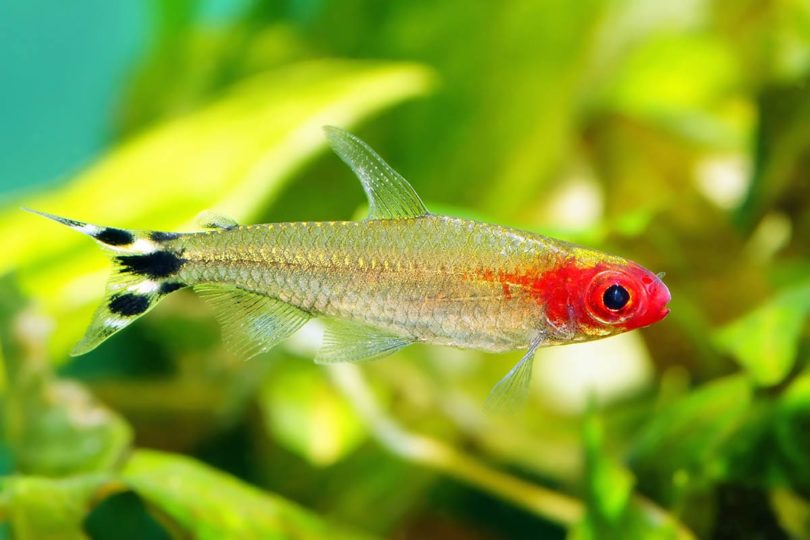Vallisneria Aquarium Plant: Care, Tank & Growing Guide

Updated on
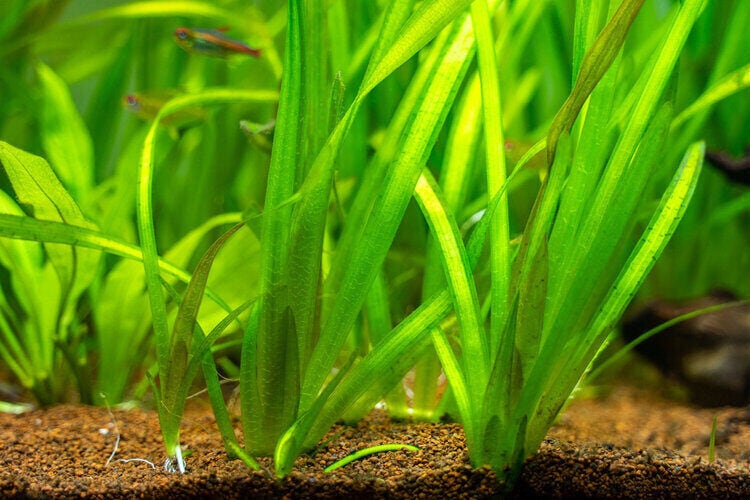
There are many easy to find and easy to care for aquarium plants widely available today, and for good reason. Low-maintenance aquarium plants can be beneficial to your tank without taking time away from caring for the aquarium’s residents.
Vallisneria is a very beginner-friendly genus of plants that bring depth and variety to tanks. Their ability to produce runners means a single plant can fill the empty space in your tank in a matter of months with proper care.
Adding a variety of Vallisneria to your tank will be a benefit to your fish and invertebrates, like shrimps. It will make your tank a more beautiful, happy home for everyone. So, here’s the information you need to know about Vallisneria plants.
Useful Information About Vallisneria
| Family Name: | Hydrocharitaceae |
| Common Name: | Vallisneria, eelgrass, tape-grass, Vallis |
| Origin: | North America, Africa, Europe, Asia |
| Color: | Light to dark green, rust red, light red, brown |
| Size: | 5 inches to 6 feet |
| Growth Rate: | Moderate to fast |
| Care Level: | Easy |
| Lighting: | Low to high |
| Water Conditions: | 64–82°F
pH 6.0–9.0 |
| Minimum Tank Size: | 10 gallons |
| Supplements: | None |
| Placement: | Middle to back of tank |
| Propagation: | Runners, sexual reproduction |
| Compatibility: | Temperate to tropical freshwater tanks |
Vallisneria Appearance

Vallisneria plants have a tall, grass-like appearance. There are multiple different varieties of these plants with a wide range of heights.
Different varieties have different leaf shapes, but they all have rounded leaf tips, which makes them stand out from other aquatic plants like swords and Anubias. Vallisneria leaves are textured with raised veins. The leaves are usually green but can take on red or brown shades based on the care of the plant and the variety.
Vallisneria grows to the water’s surface and then continues growing, flowing nicely on top of the water.
These plants usually propagate by runners, even creating aquatic meadows comprised of dozens of plants. Vallisneria can also reproduce via sexual reproduction with plants producing long stalks that extend above the waterline. These stalks will produce one male or female flower that peeks above the water’s surface. Male flowers will break off of the stalk and float in the water, “searching” for a female flower to pollinate. Once pollinated, female flower stalks will draw down into the water to protect the pollinated flower. The flowers may be green, white, or pink-tinged.
Vallisneria plants can also produce tall seed pods with multiple small, rounded seeds all over them.
Where to Find It
Vallisneria plants grow across most of the United States, parts of Canada, and Central America, as well as tropical and subtropical parts of southern Europe and northern Africa. They are also native to Papua New Guinea, the Philippines, China, Korea, India, and the list goes on.
Vallisneria are beginner-friendly plants and reproduce readily. This makes them easy to find in small, local aquarium and pond stores as well as commercial pet stores. Vallisneria plants are also easy to find in online shops and special varieties of these plants may have to be purchased online.
General Care
Vallisneria plants are known for their graceful, grassy appearance. They will not grow out from the top of the water, instead staying at the water’s surface and flowing with the current.
These are easy-care plants, not requiring any supplementation. They will absorb nutrients, like nitrate, from the water and can thrive without supplementation. Supplements can be added to the water to increase growth and bring out different colors. This can also be achieved by increasing the amount of light the plant receives.
- Vallisneria tortifolia is a dwarf variety of Vallisneria, only reaching around 8 inches in height. The leaves are green, thin, and tightly-coiled.
- Vallisneria Asiatica has beautifully spiraling leaves that can reach upwards of 30 inches in height. The leaves are usually light green but can take on a reddish coloration.
- Vallisneria Americana can survive brackish water and grows up to 6 feet in height. The leaves are green to red and may have a wrinkled appearance with vertical stripes.
- Vallisneria gigantea is a variety of Vallisneria Americana that is sometimes called Jungle Vallisneria. It can exceed 6 feet in height.
- Vallisneria nana reaches up to 20 inches in height. This plant is very similar in appearance to hairgrass, with tall, very thin leaves that are green to red.
- Vallisneria torta is a smaller version of Vallisneria Asiatica, with spiraling leaves that reach up to 20 inches in height.
- Vallisneria spiralis has thin, straight, bright green leaves that reach around 30 inches. The plant gets its name from the spiraling stem the flowers grow on.
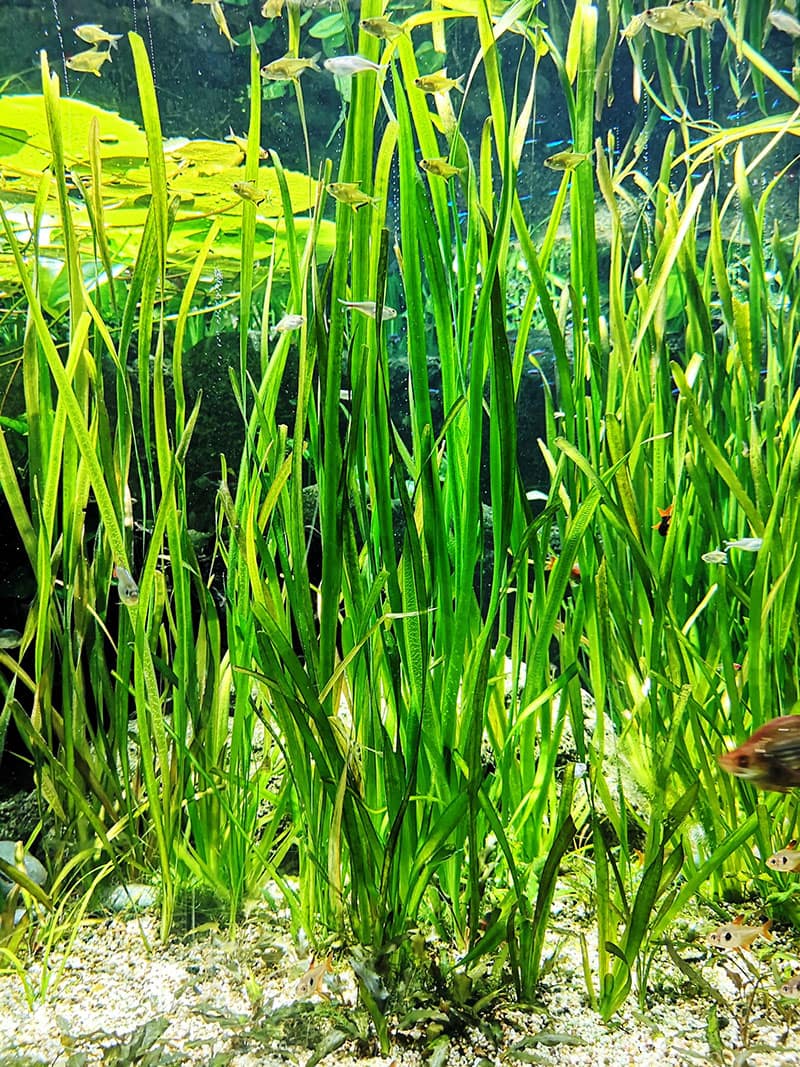
Habitat, Tank Conditions & Setup
Tank/Aquarium Size
Dwarf varieties of Vallisneria plants can be planted in 10-gallon tanks but may require pruning and removal of runners to keep the plant from overrunning the tank. Larger types of Vallisneria plants will require a much larger tank since the largest varieties can reach up to 6 feet in height and can quickly take over a tank. In fact, Vallisneria Americana is recommended for tanks 100 gallons and up!
Water Temperature and pH
Vallisneria plants can survive in temperatures from 60–84°F, but grow best between 64–82°F. They are heat and cold tolerant for long periods of time but may not grow under these circumstances. They will grow well with a pH of 6.5–8.5 but will survive in pH from 6.0–9.0.
Substrate
These plants require a substrate to grow and prefer a fine-grained substrate like sand or gravel.
Plants
Vallisneria plants can be kept with other types of plants in the aquarium, but since the Vallisneria is likely to take over a large amount of space in the tank, it’s advisable to choose smaller, foreground plants like mosses and smaller varieties of swords.
Lighting
Vallisneria plants prefer moderate lighting. In low lighting, they will survive but not thrive. In high lighting, they will often grow quickly and send runners out rapidly. Brighter light exposure may help your Vallisneria leaves take on a red hue.
Filtration
These plants grow best in well-filtered water and can live in low to high currents if they are well anchored in the substrate.
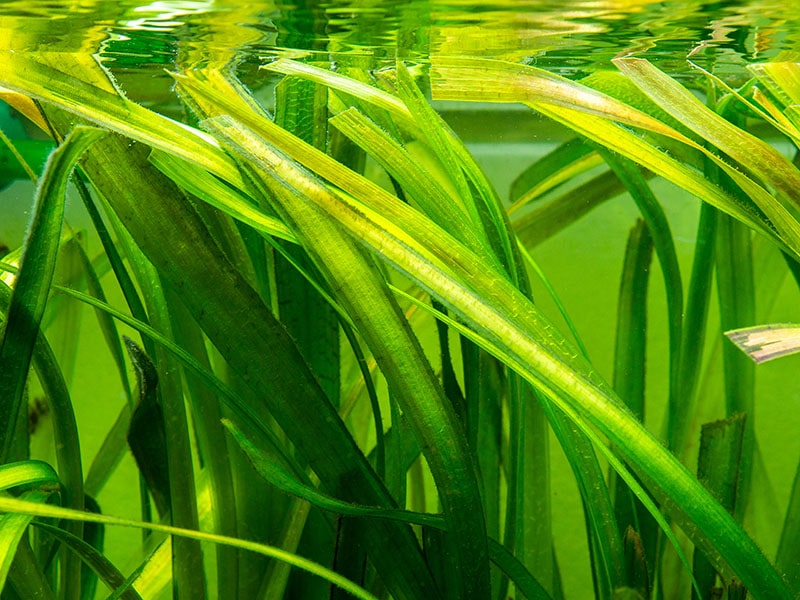
Planting Tips
Vallisneria plants should be planted into your aquarium substrate. These plants have true roots that need to be under the substrate. They can be planted with a root tab below them for maximum nutrient absorption and growth, but this is not necessary.
When planting these plants, it’s important to be aware of the crown of the plant. The crown is a light-colored area at the base of the plant, just above the roots. This part of the plant should not be planted under the substrate. If the crown is planted, the plant can die.
Most Vallisneria varieties should be planted toward the back of the tank since they can become very tall. Dwarf varieties may be appropriate for the front of the tank based on your preferences.
The 5 Benefits of Having Vallisneria in Your Aquarium
1. Safety and security
Vallisneria’s tall, grass-like leaves make a perfect hiding place for fry and shy fish. Fish will enjoy swimming through the leaves of this plant and will appreciate the more natural appearance it gives their environment.
2. Improves water quality
Vallisneria plants absorb nitrates and CO2 from the water, releasing precious oxygen in return. The more nutrients there are in the water, the more your Vallisneria will grow.
3. Reduces algae
Vallisneria does an excellent job of absorbing nutrients from the water that algae may otherwise use to take hold of your tank. Algae appreciate nutrients in the water, but Vallisneria is a higher plant and can outcompete algae for resources.
4. Hardiness
These plants are a great option for the beginner aquarist due to their ease of growth. They are hardy to a broad range of temperatures and pH levels, as well as being able to live in low lighting. Low light requirements mean that you may not even need a tank light if there is natural lighting in the room.
5. Great for aquascaping
Vallisneria grow and reproduce rapidly, allowing them to take up a lot of space in a tank. You could successfully aquascape an entire tank with one Vallisneria plant with patience and care.
Concerns About Vallisneria
Vallisneria plants are unappetizing to fish but this does not stop destructive fish from uprooting them. Goldfish and cichlids are notorious for this behavior and Vallisneria plants will take time to root enough to avoid being uprooted by fish. You can attempt to get around this issue with plant weights, in-tank pots, or barriers, but destructive fish will likely solve this problem after a while.
The main concern with Vallisneria plants is how quickly and easily it reproduces. This means that it can take over a tank if you are not vigilant with pruning and removing plantlets your tank doesn’t have space for. Be prepared to monitor for the appearance of small plantlets before they get large or send out new runners.
Conclusion
Vallisneria plants are a lovely addition to tanks, bringing a delicate elegance that also benefits your fish. Many types of fish will enjoy these grassy plants, using them for shelter and breeding.
They are great starter plants for new aquarists, helping you get your feet wet, so to speak. They are low-maintenance plants and do not require fertilizer or CO2 addition in the water if there are nutrients available from fish or invertebrates. They are easy to come by and come in a variety of heights and textures, making for more interest in your tank without taking away from the beauty of your fish.
Aquatic plant keeping can be intimidating, but Vallisneria plants can help take the intimidation out of the hobby.
Related Reads:
- Amano Shrimp: Care Guide, Breeding, Lifespan, Pictures & More
- 8 Best Aquarium Plants That Don’t Need Substrate Reviews & Top Picks
Featured Image Credit: Joan Carles Juarez, Shutterstock





